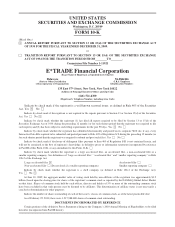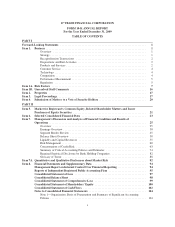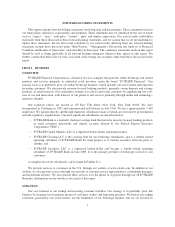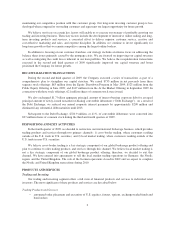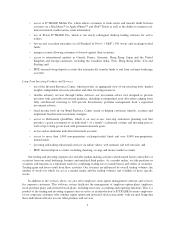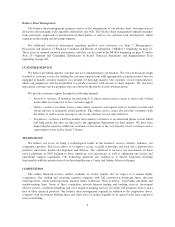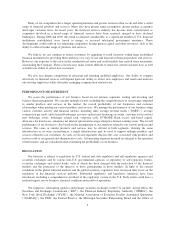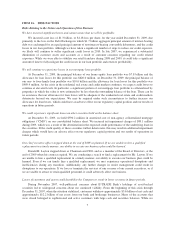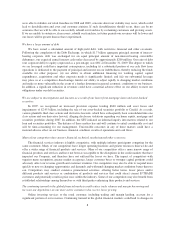eTrade 2009 Annual Report Download - page 8
Download and view the complete annual report
Please find page 8 of the 2009 eTrade annual report below. You can navigate through the pages in the report by either clicking on the pages listed below, or by using the keyword search tool below to find specific information within the annual report.Many of our competitors have longer operating histories and greater resources than we do and offer a wider
range of financial products and services. Many also have greater name recognition, greater market acceptance
and larger customer bases. In recent years, the financial services industry has become more concentrated, as
companies involved in a broad range of financial services have been acquired, merged or have declared
bankruptcy. During 2008 and 2009, this trend accelerated considerably, as a significant number of U.S. financial
institutions consolidated, were forced to merge, or received substantial government assistance. These
developments could result in our remaining competitors having greater capital and other resources, such as the
ability to offer a broader range of products and services.
We believe we can continue to attract customers by appealing to retail investors within large established
financial institutions by providing them with low-cost, easy to use and innovative financial products and services.
However, our exposure to the crisis in the residential real estate and credit markets has created some uncertainty
surrounding the Company. These concerns may make it more difficult to retain our current customer base as well
as hinder our ability to attract new customers.
We also face intense competition in attracting and retaining qualified employees. Our ability to compete
effectively in financial services will depend upon our ability to attract new employees and retain and motivate
our existing employees while efficiently managing compensation related costs.
PERFORMANCE MEASUREMENT
We assess the performance of our business based on our primary segments, trading and investing and
balance sheet management. We consider multiple factors, including the competitiveness of our pricing compared
to similar products and services in the market, the overall profitability of our businesses and customer
relationships when pricing our various products and services. We manage the performance of our business using
various customer activity and financial metrics, including daily average revenue trades (“DARTs”), average
commission per trade, end of period brokerage accounts and net new brokerage accounts, customer assets and net
new brokerage assets, brokerage related cash, corporate cash, E*TRADE Bank excess risk-based capital,
allowance for loan losses, enterprise net interest spread and average enterprise interest-earning assets. The overall
performance of our business is also based on the management of our expenses related to our various products and
services. The same or similar products and services may be offered to both segments, utilizing the same
infrastructure or in some circumstances, a single infrastructure may be used to support multiple products and
services offered to our customers. As such, we do not separately disclose the costs associated with products and
services sold or our general and administrative costs. All operating expenses incurred are integral to the operation
of the business and are considered when evaluating the profitability of our business.
REGULATION
Our business is subject to regulation by U.S. federal and state regulatory and self-regulatory agencies and
securities exchanges and by various non-U.S. governmental agencies or regulatory or self-regulatory bodies,
securities exchanges and central banks, each of which has been charged with the protection of the financial
markets and the protection of the interests of those participating in those markets. In light of the current
conditions in the global financial markets and the global economy, regulators have increased their focus on the
regulation of the financial services industry. Substantial regulatory and legislative initiatives have been
introduced, including a comprehensive overhaul of the regulatory system in the U.S. Such action could have a
material impact on our business, financial condition and results of operations.
Our regulators, rulemaking agencies and primary securities exchanges in the U.S. include, among others, the
Securities and Exchange Commission (“SEC”), the Financial Industry Regulatory Authority (“FINRA”), the
New York Stock Exchange (“NYSE”), the National Association of Securities Dealers Automated Quotations
(“NASDAQ”), the FDIC, the Federal Reserve, the Municipal Securities Rulemaking Board and the Office of
5

